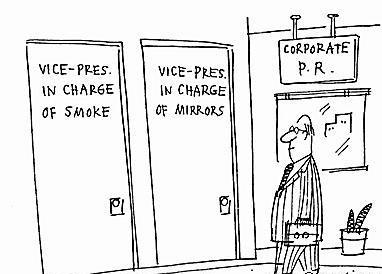
Six Steps in Handling a PR Crisis
During a corporate PR crisis, know that without having sufficient pre-planning in place the operational response will break down, customers will see this as a lethargic/half-hearted response or an ignored response and potentially escalate the situation and the brand perception of the company, especially that of management may appear weak, inept and potential civilly or criminally liable.
I have had to manage a few such instances recently to include 1) a major healthcare provider, 2) a Fortune 500 financial institution and 3) a well know fashion well know fashion house. The same techniques can really be applied to any PR or any customer service situation. Remember that there are no easy fixes in crisis management, but the following guidelines should help guide a resolution. If there is a contingency plan, follow it. If not, use the following guidelines to framework for your response.
Step 1. Demand Transparency Internally. If you are the prices manager, the burden of investigation will be on your hands. Take nothing at face value, trust yet verify all of the information received prior to formulating your response. I had client heavily vested into the political arena. I consider myself very much like a lawyer or doctor; I can only help you if you tell me what hurts and where. I require all of my clients to be 100% truthful about their needs and situation. In this case, the client could not stop softening the truth as he called it. Several crises into the project, I began to see character flaws in which my client’s improprieties and lack of candor was the root cause of. Regardless of the money, I require the upmost truth from those I work with. Anything less is not acceptable. I ended up firing the client. If you as a crisis manager are not getting adequate information or responses from your team, escalate to the next level of management ASAP. Do not forget to document everything.
Step 2. Understand what is at stake, Empathize. You need to see every situation through the eyes of your opposition. This may be a customer, partner, environmental group, government regulator or even the media. One of the largest healthcare processors for Medicare/Medicaid ran into a PR nightmare when it was discovered that an excess of $50 MM went uncollected. Jobs of heath care workers, patients and the $1 BB, 10-year contract of this healthcare processor was in peril. In any potential crisis situation where emotions or tempers may be raw it is important to be removed and objective. It is hard for you to address the pain of others without understanding how deep that pain may dwell. There is no one golden bullet statement or action. Tailor your crisis interactions always from the point(s) of the audiences affected.
Step 3. Own it or Assess the Situation! If you know without a shadow of a doubt that you or your company is at fault for the current crisis, then own it! Some good examples of crisis PR that I have working on was a the 2010 Gulf Oil Spill, a 2009 pharmaceutical manufacture that forgets to put the safety seal on a pharmaceuticals or a 2013 major fast food chain gets a report that metal shards were found in a taco meal. In these examples the responsible party was not necessarily clear. So, if your not sure, restate the situation to the respective parties, with empathy. ALWAYS…Tell the truth. By nature, people will avoid pain at all costs.
The following scenario is crisis PR, where guilt is purely by your association with a particular company or individual. The best approach is to own the relationship, have disbelief on the allegations, then create an out. For Example if the press asks about a relationship concerning an individual or company engaged in a (ENTER IN ANY CRISIS HERE – insider trading, embezzlement, etc.)
- Press: Was this man a friend?
- Your response: He is not just a friend he was my very good friend!
- Press: What this man a very good friend of yours?
- Your response: We were lifelong friends
- Press: Did you know that your lifelong friend is under investigations for X?
- Your response: I would be very surprised. I know his family, our kids go to school together, and this would be very much out of character. I will wait and that these allegations have no merit.
This gives the media no place to go because you ripped the Band-Aid off quickly. It may sting ALOT, but the worst of the pain is over.
Step 4. Have a Plan. Now it’s time to really investigate what happened and how to resolve with the least impact to your brand reputation. Always put a timetable with any process and document the progress. Releasing updates in the situations resolution shows strong leadership that is progressing to a resolution. People and press hate double speak, so insuring strong communication with those that will ultimately influence your brand is big. It is when NO action is taken that issues exponentially grow and become viral. Bottom line, if you don’t prepare, you will incur more damage. Don’t forget to continually monitor your situation this can range to viewing all news networks, monitoring social media to having boots on the ground giving near real time updates as the situation unfolds.
Step 5. Create Governance. Best phrased by Irish playwright, George Bernard Shaw, “If history repeats itself, and the unexpected always happens, how incapable must Man be of learning from experience.” In senescence, crisis PR should never be used as a witch-hunt to serve up a head to the mob. This is on opportunity to my your organization better, by putting in the checks and balances to insure that this particular crisis is not likely to recur.
Step 6. Self-Assess / Create a Contingency Plan. There is nothing wrong with being paranoid and having a contingency plan for the most common challenges that can arise with your particular market. As a benchmark, look at the crisis of other brands within the your industry. Then, you will need to preform an objective PR best practices assessment on how to handle. So, when / if the issues ever arises there is an established playbook on how to resolve without it becoming a PR crisis via proper handling. This will lay the groundwork for conducting a vulnerability audit (the first step in crisis preparedness), what I often find is a failure to address the many communications issues related to crisis/disaster response.
Please feel free to comment.




Recent Comments